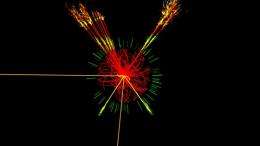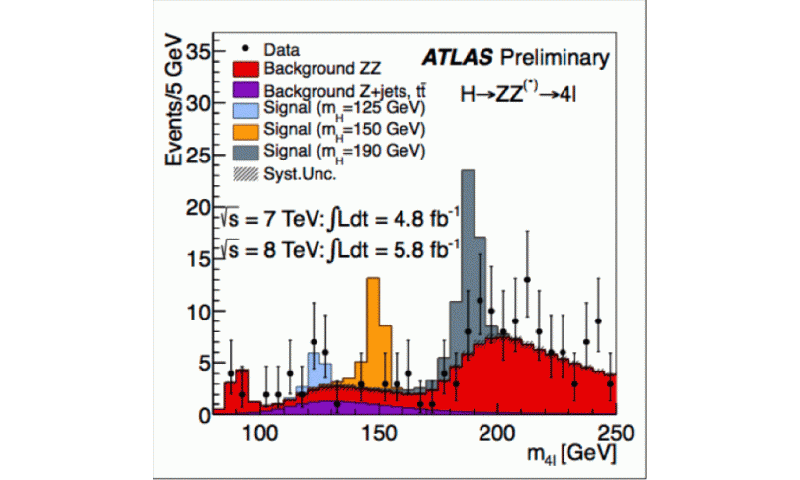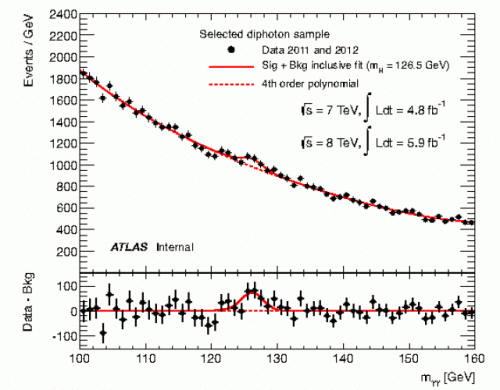CERN physicists report strong evidence of Higgs boson (w/ live video from CERN)

Two independent teams at the world's biggest atom smasher say they have both "observed" a new subatomic particle — a boson — that looks just like the one believed to give all matter in the universe size and shape.
One of the two independent teams at the world's biggest atom smasher said Wednesday it has found strong evidence of a new subatomic particle that looks like the one believed to give all matter in the universe size and shape.
Related: Eureka! Physicists celebrate evidence of particle
Joe Incandela, leader of one of the teams known as CMS, told scientists at the European Center for Nuclear Research, or CERN, that his team of 2,100 scientists has "observed" a new particle that is a boson — the same type of particle as the long-sought Higgs boson, popularly referred to as the "God particle."
He described the data as consistent with the elusive Higgs boson, whose existence was predicted decades ago to help explain how the universe works, but stopped short of definitively declaring discovery of the Higgs boson.
The second team was just starting to present its evidence before a packed auditorium, where scientists broke into applause intermittently.
Fabiola Gianotti, leader of the second team of some 3,000 scientists, known as ATLAS, said it also has observed some "beautiful" events in CERN's atom smasher, the $10 billion Large Hadron Collider on the Swiss-French border.
It has been creating high-energy collisions of protons to investigate dark matter, antimatter and the creation of the universe, which many theorize occurred in a massive explosion known as the Big Bang.
Update: The head of the world's biggest atom smasher says they have discovered a new particle that is consistent with the long-sought Higgs boson known popularly as the "God particle," which is believed to give all matter in the universe size and shape
Rolf Heuer, director of the European Center for Nuclear Research, or CERN, says "we have a discovery" of a new subatomic particle, a boson, that is "consistent with a Higgs boson."
He spoke after two independent teams at CERN said they have both "observed" a new particle.
The live video from CERN is no longer available.
-

On 4 July, 2012, the ATLAS experiment presented a preview of its updated results on the search for the Higgs Boson. © 2012 CERN -

© 2012 CERN
Official CERN Statement:
CERN experiments observe particle consistent with long-sought Higgs boson
At a seminar held at CERN today as a curtain raiser to the year’s major particle physics conference, ICHEP2012 in Melbourne, the ATLAS and CMS experiments presented their latest preliminary results in the search for the long sought Higgs particle. Both experiments observe a new particle in the mass region around 125-126 GeV.
“We observe in our data clear signs of a new particle, at the level of 5 sigma, in the mass region around 126 GeV. The outstanding performance of the LHC and ATLAS and the huge efforts of many people have brought us to this exciting stage,” said ATLAS experiment spokesperson Fabiola Gianotti, “but a little more time is needed to prepare these results for publication.”
"The results are preliminary but the 5 sigma signal at around 125 GeV we’re seeing is dramatic. This is indeed a new particle. We know it must be a boson and it’s the heaviest boson ever found,” said CMS experiment spokesperson Joe Incandela. “The implications are very significant and it is precisely for this reason that we must be extremely diligent in all of our studies and cross-checks."
“It’s hard not to get excited by these results,” said CERN Research Director Sergio Bertolucci. “ We stated last year that in 2012 we would either find a new Higgs-like particle or exclude the existence of the Standard Model Higgs. With all the necessary caution, it looks to me that we are at a branching point: the observation of this new particle indicates the path for the future towards a more detailed understanding of what we’re seeing in the data.”
The results presented today are labelled preliminary. They are based on data collected in 2011 and 2012, with the 2012 data still under analysis. Publication of the analyses shown today is expected around the end of July. A more complete picture of today’s observations will emerge later this year after the LHC provides the experiments with more data.
The next step will be to determine the precise nature of the particle and its significance for our understanding of the universe. Are its properties as expected for the long-sought Higgs boson, the final missing ingredient in the Standard Model of particle physics? Or is it something more exotic? The Standard Model describes the fundamental particles from which we, and every visible thing in the universe, are made, and the forces acting between them. All the matter that we can see, however, appears to be no more than about 4% of the total. A more exotic version of the Higgs particle could be a bridge to understanding the 96% of the universe that remains obscure.
“We have reached a milestone in our understanding of nature,” said CERN Director General Rolf Heuer. “The discovery of a particle consistent with the Higgs boson opens the way to more detailed studies, requiring larger statistics, which will pin down the new particle’s properties, and is likely to shed light on other mysteries of our universe.”
Positive identification of the new particle’s characteristics will take considerable time and data. But whatever form the Higgs particle takes, our knowledge of the fundamental structure of matter is about to take a major step forward.
Andy Parker, Professor of High Energy Physics at the Cavendish Laboratory, sheds light on today’s announcement and ‘what next’
Andy Parker is the Professor of High Energy Physics at the University of Cambridge’s Department of Physics (the Cavendish Laboratory). His current research interests involve experiments to reveal new physics such as extra space dimensions, quantum-sized black holes, and supersymmetry. He is a founder of the ATLAS experiment for the LHC, and for 6 years he was the project leader for the ATLAS Inner Detector. Below, he answers some questions surrounding the Higgs boson.
1. What is the Higgs Boson?
Most people imagine particles of matter to be like little billiard balls, which are stuck together in some way to make the solid objects which we see around us. We naturally expect the billiard balls to have some substance in their own right, making them, and everything which they form, massive. However, in modern quantum theories, matter is nothing like this. All the particles would, if left to themselves, have no mass at all, and fly around at the speed of light. There would be no atoms or people to study them.
The Higgs field is the proposed answer to this mismatch between our equations and what we see. The Higgs field fills all of space, and as the particles try to move through it, their interactions with it cause them to appear to have mass. This slows them down and allows them to bind together into the familiar forms of matter which we observe. This is a completely different picture of nature than the one we instinctively imagine – instead of matter having its own intrinsic properties, and moving about in empty space, many of the properties of matter are actually only due to its interactions with an invisible, all-pervasive field. The properties of “empty” space are crucial to the physicist’s understanding of the world.
The Higgs boson itself is a vibration in the Higgs field, which can be created if enough energy is put into the field, like dropping a pebble into a pond. The LHC is the world’s highest energy particle collider, and the collisions it makes create enough disturbance in the Higgs field to observe the Higgs boson, if it exists.
2. Today CERN announced an update on the research, what did they find?
In December last year, CERN announced that the two large LHC experiments, ATLAS and CMS had both seen indications of extra events at one particular energy. This is consistent with what one would expect from a Higgs boson whose mass matches that energy (energy and mass are related by E=mc^2). However, there were not enough extra events to be certain that the effect was not simply due to chance. Rolling a dice and getting three sixes in a row does not prove that the dice is loaded. You need a few more sixes to be sure. In order to confirm the observation, the experiments have been collecting more data this year.
Today, the scientists at CERN have confirmed that they have found a new particle consistent with the long-sought Higgs Boson.
3. What more needs to happen for CERN scientists to confirm that the unexplained particle is indeed a Higgs Boson?
The Standard Model Higgs Boson has very specific properties. It does not exist for very long, decaying into normal particles which we observe in the detector. We know how often it should be seen in each type of decay, but to check this requires a lot of data to analyse. Once we have checked the observations in detail, it will be possible to say with much more confidence whether they are consistent with the Standard Model Higgs predictions. The LHC will continue running until the end of this year, and is expected to deliver twice as much data as we have so far. After that, it will be upgraded, and will be able to run at higher energy, which will help with the measurements.
4. In the Standard Model (the simplest theory which describes the fundamental subatomic particles and the forces between them) it is hypothesized that there is only one Higgs Boson, but in the Supersymmetric Model (which, unlike the Standard Model, incorporates the physics of dark energy and the full theory of gravitation) there could be up to five Higgs Boson. If they are able to verify the signal is indeed a Higgs Boson, how will they know if it is one of many?
The detailed decay properties of a supersymmetric Higgs Boson are different from those of the Standard Model version. Therefore, with sufficiently precise data we will be able to tell the difference.
5. If the Higgs verifies the Standard model, does more than one Higgs undermine it in favour of Supersymmetry?
Supersymmetry is an extension of the Standard Model, rather than a replacement. The Standard Model will always remain as an excellent description of Nature at energies below those explored at the LHC. But supersymmetry may be needed to explain observations at higher energies, for example if we see extra Higgs particles, or other supersymmetric partners of normal matter. This is similar to the way in which Einstein’s General Relativity is the best description of very strong gravitational fields, but Newton’s gravity works perfectly well for almost all normal situations.
6. If the Higgs Boson particle(s) is confirmed, what are the next stages of research?
There will be several parallel strands of activity. The first would be to measure the properties of the observed particle in as much detail as possible, in order to check whether it is consistent with the Standard Model. The existence of a Higgs Boson at a mass around 126 GeV (gigaelectronvolt, a unit of energy equal to billion electron volts), if confirmed, would strongly suggest that other new particles are awaiting discovery. These might be supersymmetric for example. Therefore, a second strand, already under way, is to look for evidence of supersymmetry. This could be by detecting the emission of dark matter particles in LHC collisions. We are also searching directly for supersymmetric Higgs bosons. The Cambridge team is a world leader in supersymmetry research, both theoretical and experimental.
The third strand is to check for other hypotheses, of which extra space dimensions is particularly appealing. If the world has extra space dimensions, this could explain why the Higgs boson appears where it does. It seems odd that we cannot see these extra dimensions, but this is because they are supposed to be curled up into tiny circles. Looked at from afar, a piece of string looks one-dimensional, but close up, you can see an ant walk around it. Similarly, we cannot see the curled up dimensions unless we look at very short distances. The LHC works as an extremely powerful microscope which may reveal them. If extra space dimensions exist, then we would expect gravity to become much stronger at very short distances. This would be observable at the LHC, and would help to resolve the century-old puzzle of how to make quantum mechanics compatible with General Relativity.
At present, our picture of the sub-atomic world, ruled by quantum mechanics, is incompatible with our picture of the astronomical world, ruled by gravity. The Cambridge group is active in all of these areas. Once we are certain of the status of the Higgs hypothesis, it will become much easier to make testable predictions about the bigger picture. We can expect the programme of research at the LHC to continue well into the next decade.
(Source: University of Cambridge)
Copyright 2012 The Associated Press. All rights reserved. This material may not be published, broadcast, rewritten or redistributed.



















